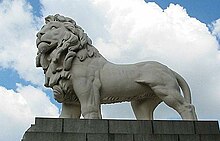Coade stone
Coade stone is a ceramic mass similar to stoneware with the properties of an artificial stone . It was invented by Eleanor Coade (1733–1821) and manufactured and sold from 1769 to 1833. The material was used for the series production of facade parts, decorative sculptures and garden decorations in England in the late 18th and early 19th centuries. The Coade stone is now out of use because the substance was replaced by the cheaper Portland cement .
history
In order to meet the great demand for facade decoration mainly for the bright brick buildings in London at the time of George III. To be able to follow, Eleanor Coade had developed a hard and weather-resistant artificial stone. The raw material could be poured into molds and allowed the manufacture of work pieces from brick size to complete still images. In particular, pre-fabricated parts of window cornices and doorways at affordable prices were so in demand that Eleanor Coade set up a factory, Coade's Artificial Stone Company . You could advertise with famous customers such as the royal family and members of the English nobility.
Despite the great success of the company in the London district of Lambeth , which presented a large number of different jewelry elements in its sales rooms, after the death of the company founder in 1821 it was not possible for her daughter and her relatives to secure the future of the company in the long term. The company went bankrupt in 1833.

Manufacture and composition
Eleanor Coade's name, which did not catch on , was Lithodipyra , an artificial word made up of Greek parts of the word (“two stone fire”). The color of the material was between light gray and beige, the surface of the finished workpieces had a matt sheen. The great advantage of this ceramic was its ability to be easily poured into large molds with highly structured surfaces. The molds could be reused for a long time. The hard and smooth surfaces were also extremely weatherproof and defied the aggressive London climate, which was heavily polluted by the smoke gases produced by the burning of coal. In this environment, the Coade stone was superior to most natural stones, which were also time-consuming and expensive to work.
Contrary to popular belief that the recipe for making the raw material for the Coade stone is lost, its composition is well known. The material from which the green body was made consisted of
- 60-70% clay (from Dorset and Devon ),
- 10% ground soda-lime glass ,
- 5–10% ground flint ,
- 5–10% quartz (to reduce the shrinkage process),
- 10% ground stoneware as lean (obtained from rejects).
The mixture prepared from it was kneaded, shaped into a green body and fired in kilns at over 1100 degrees Celsius for four days. The art of making was less about knowing the recipe than about the special skills required to oversee its making and the difficult firing process. Eleanor Coade's company therefore remained the only successful manufacturer of this artificial stone.
Existing examples
According to the results of research by the BBC in 2004, there are still 650 individual pieces or building facades made of Coade stone worldwide. The best-known example in Great Britain is the Red Lion from 1837, a former London brewery. The sculpture is now at the south end of Westminster Bridge in London.